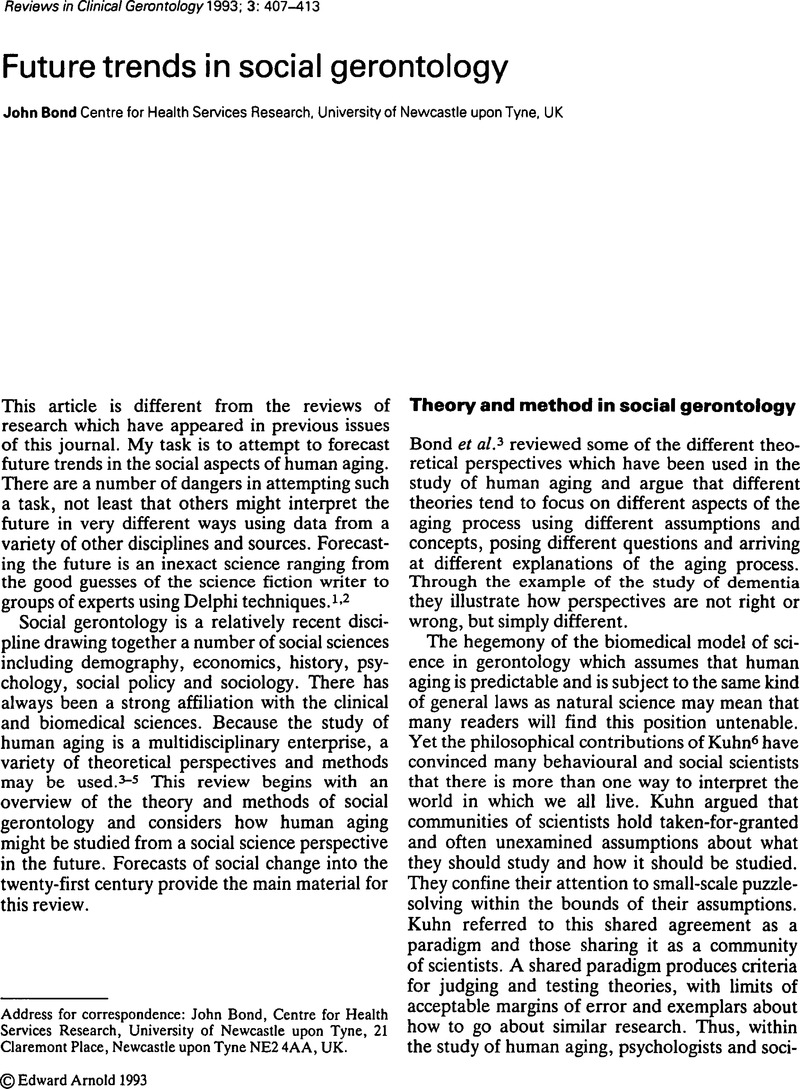No CrossRef data available.
Article contents
Future trends in social gerontology
Published online by Cambridge University Press: 17 November 2008
Abstract
An abstract is not available for this content so a preview has been provided. Please use the Get access link above for information on how to access this content.

- Type
- Social and psychological gerontology
- Information
- Copyright
- Copyright © Cambridge University Press 1993
References
1Sackman, H.Delphi assessment: expert opinion, forecasting, and group processes etc. Santa Monica: Rand Corporation, 1974.Google Scholar
2Linstone, HA, Turoff, M.The Delphi method. Techniques and applications. Massachusetts: Addison-Wesley, 1975.Google Scholar
3Bond, J, Briggs, R, Coleman, P. The study of ageing. In: Bond, J, Coleman, P, Peace, S eds. Ageing in society. An introduction to social gerontology, second edition. London: Sage Publications, 1993.Google Scholar
5Peace, S.Researching social gerontology. Concepts, methods and issues. London: Sage Publications, 1990.Google Scholar
6Kuhn, TS.The structure of scientific revolutions. Chicago: Chicago University Press, 1962.Google Scholar
7Neisser, U.Memory observed: remembering in natural contexts. San Francisco: Freeman, 1982.Google Scholar
10Coleman, P. Adjustment to later life. In: Bond, J, Coleman, P, Peace, S eds. Ageing in society. An introduction to social gerontology, second edition. London: Sage Publications, 1993.Google Scholar
11Baltes, PB, Reese, HW, Lipsitt, LP.Life-span developmental psychology. Annu Rev Psychol 1980; 31: 65–110.CrossRefGoogle ScholarPubMed
12Datan, N, Rodeheaver, D, Hughes, F.Adult development and aging. Annu Rev Psychol 1987; 38: 153–80.CrossRefGoogle ScholarPubMed
13Cumming, E, Henry, WE.Growing old: the process of disengagement. New York: Basic Books, 1961.Google Scholar
15Mead, GH. On social psychology. In: Strauss, A ed. On social psychology: selected papers. Chicago: University of Chicago Press, 1964.Google Scholar
18Baars, J.The challenge of critical gerontology: the problem of social constitution. J Aging Stud 1991; 5: 219–43.CrossRefGoogle Scholar
19Gubrium, JF, Silverman, D.The politics of field research: sociology beyond enlightenment. London: Sage Publications, 1989.Google Scholar
20Cole, T.Voices and visions: toward a critical gerontology. New York: Springer, 1993.Google Scholar
21Featherstone, M, Hepworth, M. Images of ageing. In: Bond, J, Coleman, P, Peace, S eds. Ageing in society. An introduction to social gerontology, second edition. London: Sage Publications, 1993.Google Scholar
22Tornstam, L.The quo vadis of gerontology: on the scientific paradigm of gerontology. Gerontologist 1992; 32: 318–26.CrossRefGoogle Scholar
23Bond, J, Coleman, P. Ageing into the twenty-first century. In: Bond, J, Coleman, P, Peace, S eds. Ageing in society. An introduction to social gerontology, second edition. London: Sage Publications, 1993.Google Scholar
25World Health Organization. Health of the elderly. Geneva: World Health Organization, 1989.Google Scholar
26McDowell, L. Gender divisions. In: Hamnett, C, McDowell, L, Sarre, P eds. Restructuring Britain: the changing social structure. London: Sage Publications, 1989.Google Scholar
27McRae, S.Occupational change over childbirth: evidence from a national survey. Sociology 1991; 25: 589–605.CrossRefGoogle Scholar
29Laczko, F, Phillipson, C.Changing work and retirement. Milton Keynes: Open University Press, 1991.Google Scholar
30Phillipson, C. The sociology of retirement. In: Bond, J, Coleman, P, Peace, S eds. Ageing in society. An introduction to social gerontology, second edition. London: Sage Publications, 1993.Google Scholar
31Haskey, J.Trends in marriage and divorce, cohort analyses of the proportion of marriages ending in divorce. Population Trends 1988; 54: 21–28.Google Scholar
32Jerrome, D. Intimate relationships. In: Bond, J, Coleman, P, Peace, S eds. Ageing in society. An introduction to social gerontology, second edition. London: Sage Publications, 1993.Google Scholar
33Hagestad, GO, Smyer, MA, Stierman, K. Parent-child relationships in adulthood: the impact of divorce in middle age. In: Cohen, RS, Cohler, BJ, Weissman, SH eds. Parenthood: psychodynamic perspectives. New York: Guilford Press, 1984.Google Scholar
34Robinson, PK, Livingston, J, Birren, J.Aging and technological advances. New York: Plenum Press, 1984.CrossRefGoogle Scholar
35Lesnoff-Caravaglia, G.Aging in a technological society. New York: Human Sciences Press, 1988.Google Scholar
36Coleman, P, Bond, J, Peace, S. Ageing in the twentieth century. In: Bond, J, Coleman, P, Peace, S eds. Ageing in society. An introduction to social gerontology, second edition. London: Sage Publications, 1993.Google Scholar
37MacFarlane, A.Marriage and love in England: modes of reproduction 1300–1840. Oxford: Blackwell, 1986.Google Scholar
38Estes, CL. The politics of ageing in America. In: Phillipson, C, Bernard, M, Strang, P eds. Dependency and interdependency in old age: theoretical perspectives and policy alternatives. London: Croom Helm, 1986.Google Scholar
39Walker, A. Poverty and inequality in old age. In: Bond, J, Coleman, P, Peace, S eds. Ageing in society. An introduction to social gerontology, second edition. London: Sage Publications, 1993.Google Scholar
40Laslett, P.A fresh map of life: the emergence of the Third Age. London: Weidenfeld & Nicolson, 1989.Google Scholar
41Walker, A, Laczko, F. Early retirement and flexible retirement. In: House of Commons Social Services Committee. Age of retirement, HC 26-II. London: HMSO, 1982: 211–29.Google Scholar
42Bond, J. Living arrangements of elderly people. In: Bond, J, Coleman, P, Peace, S eds. Ageing in society. An introduction to social gerontology, second edition. London: Sage Publications, 1993.Google Scholar
43Hazan, H.The limbo people: a study of the constitution of the time universe among the aged. London: Routledge & Kegan Paul, 1980.Google Scholar
44Hockey, J, James, A. Metaphors of marginality: ageing, infantilisation and personhood. Paper presented at British Society of Gerontology Annual Conference, 1990.Google Scholar


